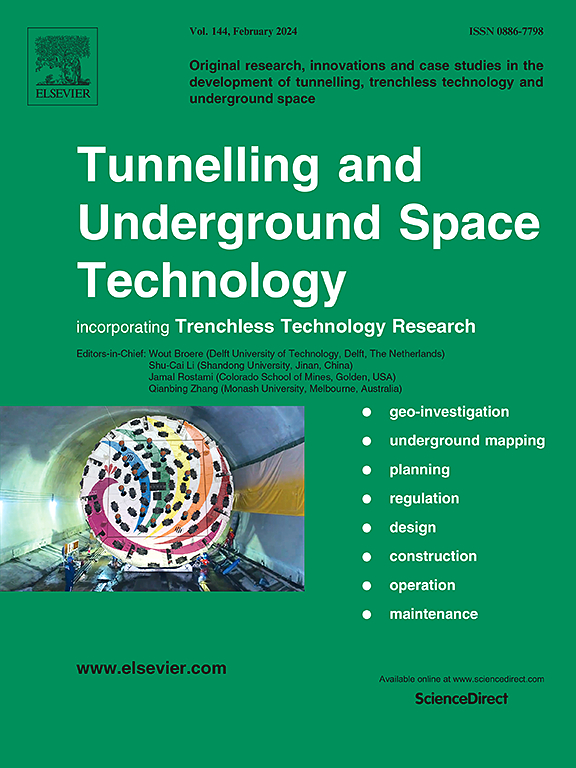Numerical investigation on the effect of cutterhead shapes on tunnel face stability
IF 6.7
1区 工程技术
Q1 CONSTRUCTION & BUILDING TECHNOLOGY
引用次数: 0
Abstract
The stability of tunnel faces under the stationary condition of an Earth Pressure Balance (EPB) machine is critical in tunnel construction. While extensive research has focused on the operational stability of tunnel faces, a significant gap remains in understanding the influence of cutterhead geometry on face stability under stationary phases. This study employs three-dimensional (3D) Finite Element (FE) analysis to investigate tunnel face stability in clay and sandy soils, emphasizing the effect of cutterhead opening area ratio (COA), cutterhead shape, and tunnel cover depth (C/D) on stability under stationary conditions. Three distinct cutterhead shapes, exhibiting varying COAs (35 %, 40 %, and 45 %), were analysed across a range of cover depths from 0.5D to 4.0D (D represents the tunnel diameter). The results indicate that larger COAs (45 %) significantly increase soil displacement and instability risks, particularly in clay soils, with critical displacements occurring after reductions of up to 40 % in support pressure. In contrast, sandy soils demonstrated enhanced stability even with larger COAs. Furthermore, the study revealed a significant influence of cutterhead design on soil displacement and support pressure. Cutterhead shape 3, characterized by symmetrical openings and a large central panel, exhibited superior performance, minimizing soil displacement and requiring up to 20 % less support pressure compared to other cutterhead shapes investigated in this study. The cover depth in the three shapes was found to influence stability, with deeper tunnels (C/D = 4.0D) at various COAs experiencing greater displacement and requiring higher support pressures, especially in clay soils. Stress distribution analysis revealed that increased COA and larger cover depths contribute to higher horizontal stress, which exacerbates face instability. Additionally, clay soils exhibited a higher propensity for instability compared to sandy soils, particularly under conditions of larger COAs and deeper cover depths. This research provides a novel approach to optimizing EPB machine performance by considering face stability in the cutterhead opening areas. The findings offer valuable insights for tunnel boring machine (TBM) design and operational planning in various ground conditions.
刀盘形状对巷道工作面稳定性影响的数值研究
在土压平衡机静止状态下,隧道工作面的稳定性是隧道施工的关键。虽然大量的研究集中在隧道工作面的运行稳定性上,但在了解固定相下刀盘几何形状对工作面稳定性的影响方面仍然存在很大的差距。本研究采用三维有限元(3D)分析方法研究了粘土和砂土中隧道工作面稳定性,重点研究了固定条件下刀盘开口面积比(COA)、刀盘形状和隧道覆盖深度(C/D)对稳定性的影响。在0.5D至4.0D (D代表隧道直径)的覆盖深度范围内,分析了三种不同的刀盘形状,表现出不同的coa(35%、40%和45%)。结果表明,较大的coa(45%)显著增加了土壤位移和不稳定风险,特别是在粘土中,在支护压力降低高达40%后发生临界位移。相比之下,即使coa较大,砂土也表现出更高的稳定性。此外,研究还揭示了刀盘设计对土体位移和支护压力的显著影响。刀盘形状3的特点是对称开口和一个大的中央面板,与本研究中调查的其他刀盘形状相比,表现出优越的性能,最大限度地减少了土壤位移,所需的支撑压力减少了20%。研究发现,三种形状的隧道覆盖深度对稳定性有影响,在不同的coa下,越深的隧道(C/D = 4.0D)位移越大,需要的支护压力也越大,尤其是在粘土土中。应力分布分析表明,COA的增大和覆盖深度的增大导致了水平应力的增大,加剧了工作面失稳。此外,与砂质土相比,粘土土表现出更高的不稳定倾向,特别是在coa较大和覆盖深度较深的情况下。该研究为考虑刀盘开口区域面的稳定性来优化EPB机床性能提供了一种新的途径。研究结果为不同地基条件下隧道掘进机的设计和运行规划提供了有价值的见解。
本文章由计算机程序翻译,如有差异,请以英文原文为准。
求助全文
约1分钟内获得全文
求助全文
来源期刊

Tunnelling and Underground Space Technology
工程技术-工程:土木
CiteScore
11.90
自引率
18.80%
发文量
454
审稿时长
10.8 months
期刊介绍:
Tunnelling and Underground Space Technology is an international journal which publishes authoritative articles encompassing the development of innovative uses of underground space and the results of high quality research into improved, more cost-effective techniques for the planning, geo-investigation, design, construction, operation and maintenance of underground and earth-sheltered structures. The journal provides an effective vehicle for the improved worldwide exchange of information on developments in underground technology - and the experience gained from its use - and is strongly committed to publishing papers on the interdisciplinary aspects of creating, planning, and regulating underground space.
 求助内容:
求助内容: 应助结果提醒方式:
应助结果提醒方式:


